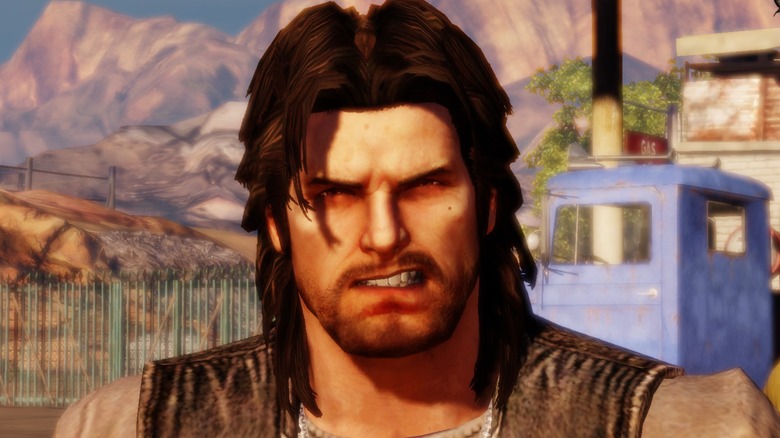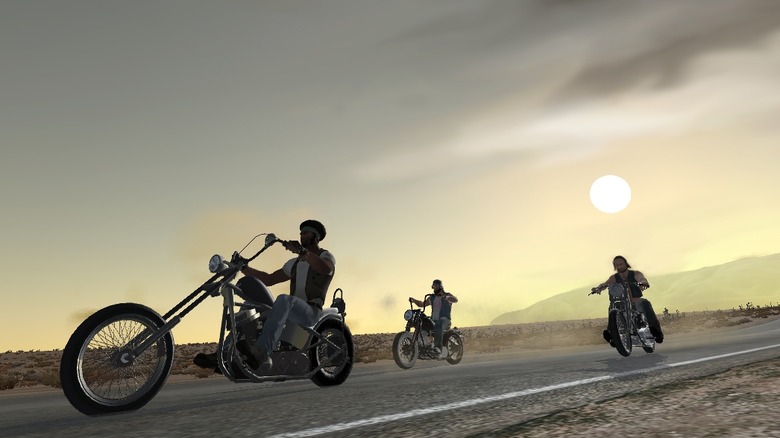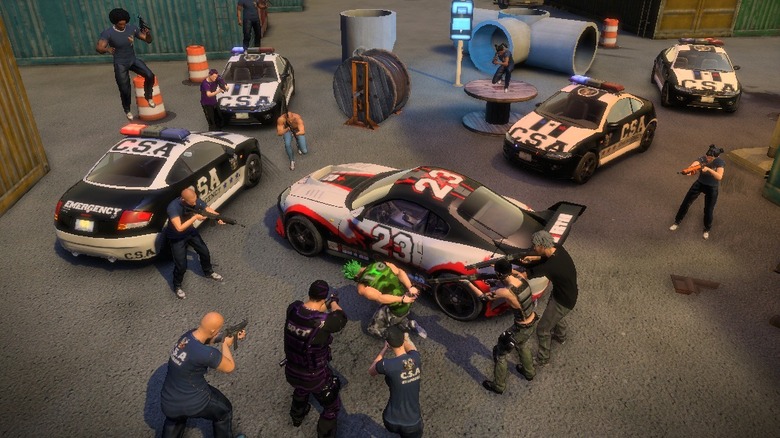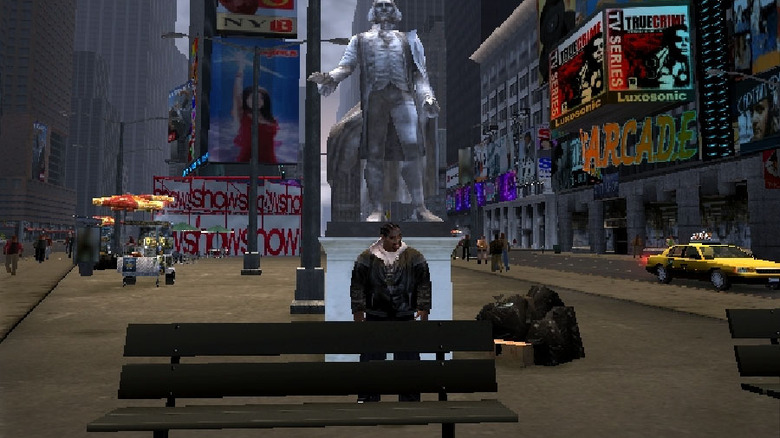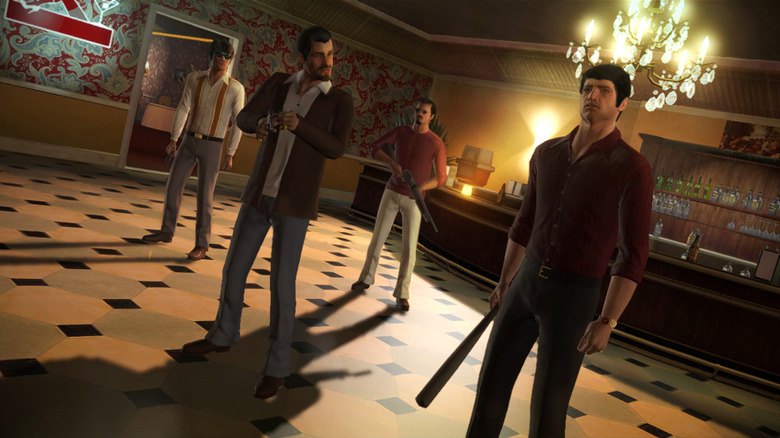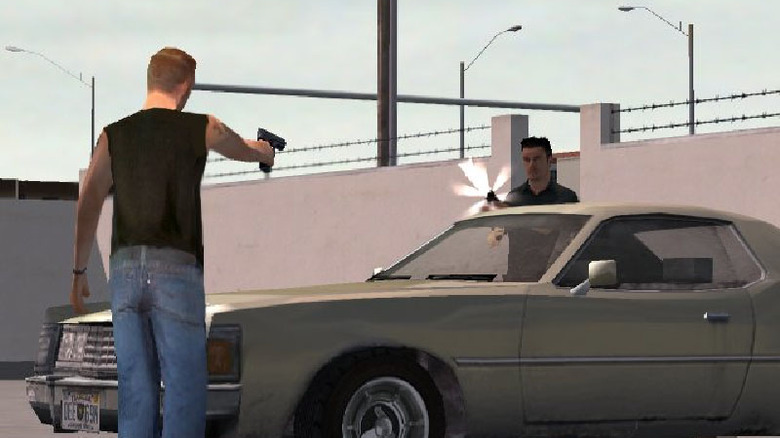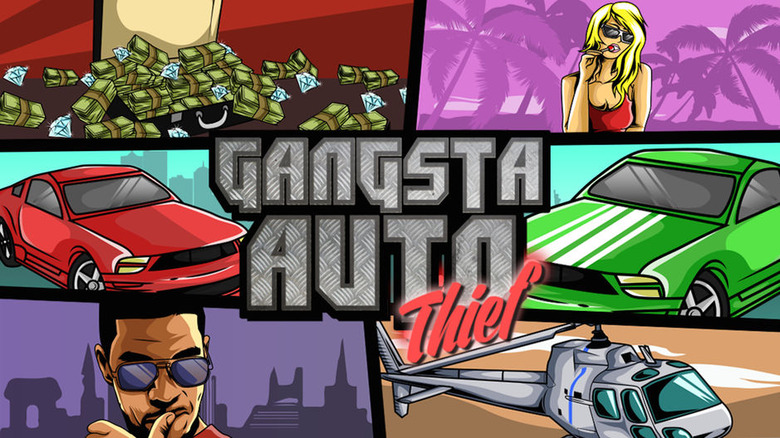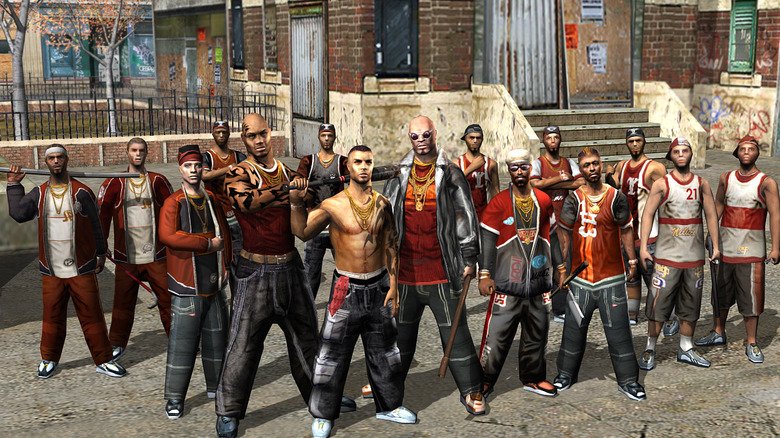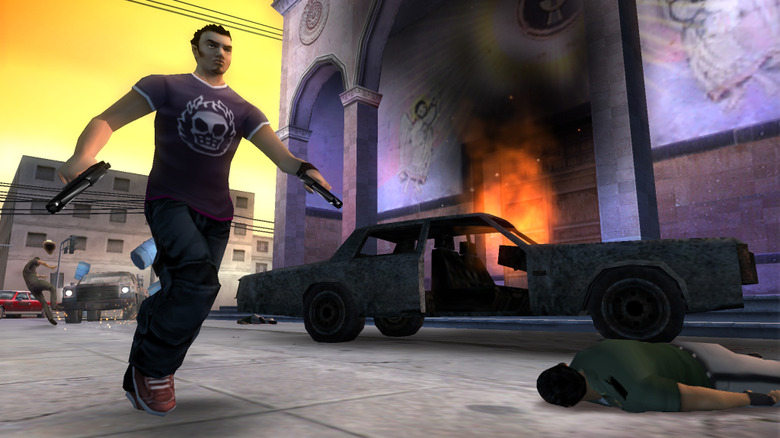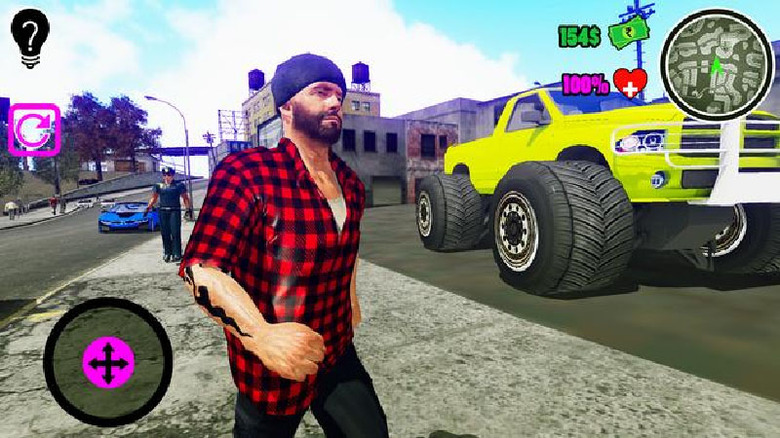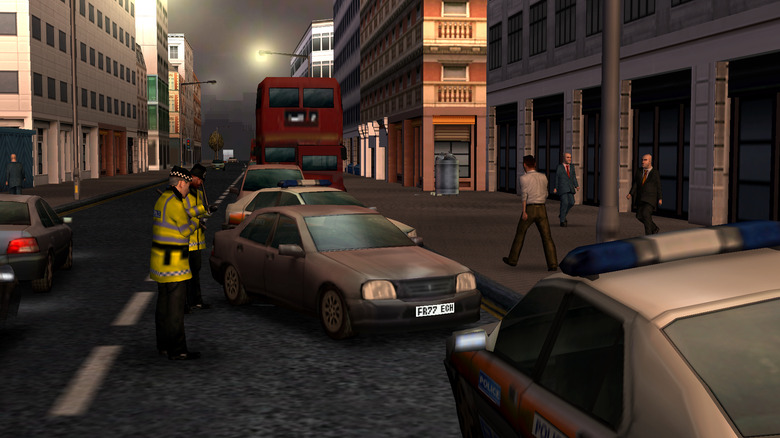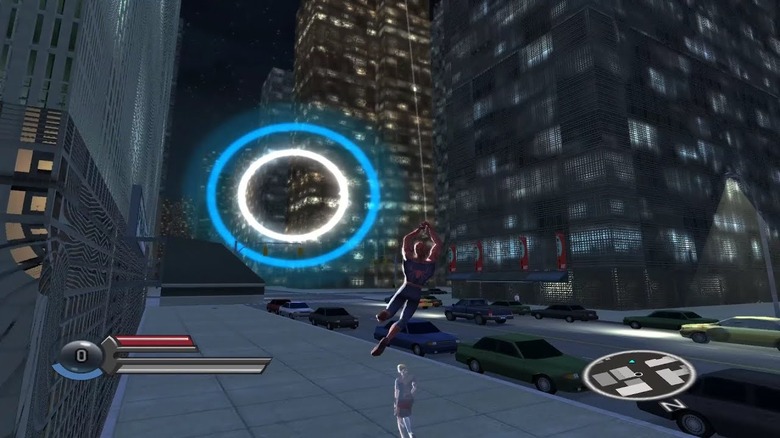Games That Tried To Rip Off GTA And Failed
Never mind video games: Grand Theft Auto is one of the biggest and most profitable properties in any type of media, and where you find a big success, you'll also find a number of copycats. You've seen these games before: open-world games set in urban environments with seedy criminal underbellies, with a mix of arcade-style driving, various forms of gunplay, and the freedom to explore and cause mischief as you see fit.
It's a winning formula, and Rockstar has had it nailed down since the very beginning. The imitators? Not so much. These games tried to capitalize on Grand Theft Auto's success by shamelessly ripping off the stuff that makes it so compelling, only to stumble well before the finishing line. Given the money at stake, you can't blame these developers for trying. Making games, especially ones as dense and complex as Grand Theft Auto, is hard. Rockstar only makes it look easy.
Ride to Hell should follow its own advice
Ride to Hell: Retribution isn't an open-world criminal simulator. It was supposed to be. When Deep Silver announced the game in 2008, Ride to Hell was a Grand Theft Auto-like trip through the 1960s' seedy underbelly. As a member of a Hells Angels-esque motorcycle gang, you'd cruise across the American West on your bike, snapping Polaroids, doing drugs, and slowly rising through the gang's ranks until you're the top dog.
Five years later, Ride to Hell: Retribution arrived, and it was not that. At all. EGM surmises that, at some point during production, Deep Silver and developer Eutechnyx realized that their ambitious were too big, and decided to take everything that they'd built and reconfigure it into something else. Unfortunately, that something ended up being one of the very worst video games ever made. Ride to Hell isn't just glitchy: it barely works at all, and on the rare occasions when it does, it's simply not fun.
Objective markers don't always lead to objectives. On-screen text is riddled with typos. Vehicles randomly explode. Every time that you complete a quest given by a woman, which is most of them, she rewards you with sex — but the characters never take off their clothes, making Ride to Hell both incredibly sexist and unintentionally hilarious. It's not even so bad it's good. It's just bad. If you're really curious, watch a few YouTube videos and move on with your life. We've already given Ride to Hell more attention than it deserves.
APB is some grade-A BS
Grand Theft Auto Online more or less prints money, so there's clearly a market for GTA-style gameplay in a multiplayer setting. There's just not much of a market for APB. On paper, APB: All Points Bulletin sounds fine. Players roam around the fictional metropolis of San Paro, either as a member of the Enforcers (the cops) or the Criminals, and face off in missions, earning money that can be spent on new weapons or cosmetic options. APB has a strong Grand Theft Auto link behind the scenes, too: it was directed by David Jones, who created Grand Theft Auto, and was billed as the culmination of everything that Jones had been working on.
So far, so good. But then APB came out, and the reviews weren't kind. Critics complained that the game felt unfinished, that the core shooting and driving systems felt sloppy and repetitive, and that San Paro's streets all looked the same. Just a couple of months after APB launched, developer Realtime Worlds went out of business, taking APB's online servers with it. Eventually, Korean games company K2 Network bought the rights to APB and relaunched it as a free-to-play title, but players soon complained that it was more pay-to-win.
Remarkably, APB: Reloaded is still around, although it's full of cheaters, toxic community members, and dated gameplay. Even its most dedicated players call it "garbage." In 2018, APB was sold to publisher Little Orbit, so improvements could be on their way. Given APB's history, however, we're not getting our hopes up.
The True Crime is that we had to play this game
True Crime: Streets of LA hasn't aged well, but when it came out in 2003, it was seen as the first open-world game to give Grand Theft Auto a real challenge. See, True Crime wasn't a straight-up GTA clone. Instead of playing as a bad guy, True Crime cast you as a cop. It had a branching storyline that changed when you succeeded or failed at a mission, making it feel like your actions mattered. Instead of a fake city, True Crime took place in a one-to-one recreation of Los Angeles, and brought along Hollywood stars like Christopher Walken, Gary Oldman, Michelle Rodriquez, and Michael Madsen with it.
That was enough to earn True Crime a sequel, and that's when the trouble started. True Crime: New York City didn't bring any new ideas to the table, and it didn't implement the old ones particularly well, either. By 2005, True Crime's basic good cop/bad cop morality system felt dated, and the city lacked New York's grimy charm. The game wasn't finished, either. Reviewers complained that the game felt rushed and that its numerous glitches made it borderline unplayable.
That killed the True Crime franchise for good. True Crime: New York City only moved about 72,000 copies, less than a third of what True Crime: Streets of LA sold in its first two weeks on the market, and plans for any sequels were scuttled. Activision briefly tried to revive the brand in 2009 but ended up selling True Crime: Hong Kong to Square Enix, which released it as Sleeping Dogs with not a mention of True Crime to be found.
The Godfather 2 is one offer that you absolutely should refuse
Francis Ford Coppola's The Godfather (and the Mario Puzo novel that it was based on) laid the foundation for every organized crime yarn that followed, including Grand Theft Auto, so it's not too surprising that someone turned it into a video game. What is surprising is that Electronic Arts managed to land a number of the film's original actors to reprise their roles, including James Caan, Robert Duvall, Abe Vigoda, and Marlon freakin' Brando in his last-ever acting performance (although Brando's lines were ultimately unusable, thanks to the oxygen tank the ailing actor was forced to use).
The Godfather: The Game wasn't a bad little GTA-like, either, even if it didn't really capture the tone of its source material or bring any new ideas to the table. The same can't be said about its sequel, however. While The Godfather: Part II is one of the rare film sequels that's even better than the first one, lightning didn't strike twice. It commits the biggest crime an open-world game can: it's boring. The Godfather 2's glitch-ridden environments all look the same, and its missions get repetitive fast.
Critics reacted accordingly, as did customers, who picked up less than a quarter-million copies. That's not much for a name as big as The Godfather, and EA sent its plans for more sequels to sleep with the fishes. Given that the next film in the queue was the notoriously awful The Godfather: Part III, that's probably a blessing.
Driver 3 will drive you mad
Amazingly, the worst thing about Driver 3 isn't its promotional title, Driv3r. It's how the game fundamentally misunderstands what makes Driver special. The first two Driver games take place in open worlds, but they aren't really GTA-likes (in fact, the original Driver debuted in 1999, a full two years before Grand Theft Auto 3 took the series into 3D). They're racing games with a narrow focus. Driver and Driver 2 feel like high-speed car chases straight out of a Hollywood blockbuster. They're fast, chaotic, and fun.
By contrast, Driver 3 tries to move the franchise into full-on Grand Theft Auto territory by making you get out of the car and fight, and that's where things fall apart (Driver 2 has some on-foot sequences, but they're not combat-based). The controls suck. The camera sucks. Shootouts rely on trial-and-error, not real skill, and the on-foot enemies are as dumb as rocks. When you're behind the wheel, Driver 3 works. When you do anything else, it's a nightmare.
If people want to play Grand Theft Auto, they'll play Grand Theft Auto. If they pick up a Driver game, they want to play Driver. Ubisoft ultimately got the series back on track with Driver: San Francisco, which returned players to their rightful place behind the dashboard, but after Driv3r it looked like the franchise was in real trouble. It's a miracle that it ever recovered.
They couldn't even get the initials right in Gangsta Auto Thief
Say you want to play some Grand Theft Auto on the go, so you head over to the iOS App Store to see what's available. You find Grand Theft Auto 3, Grand Theft Auto: Vice City, Grand Theft Auto: San Andreas, and Grand Theft Auto: Chinatown Wars all ready and available to download, but you've played those many times before. You're looking for something new.
And then you see it. Sure, there's something about Gangsta Auto Thief that seems a little fishy — for one, that's abbreviated GAT, not GTA — but the key art sure looks like what you'd find on a Grand Theft Auto game, and the description, which promises "Explosions. Tanks. Helicopters. Undercover Police. And a whole lot of mayhem," sounds about right, even if it's grammatically dubious.
Don't be fooled. Gangsta Auto Thief (full title: Gangsta Auto Thief: Reckless Gang.sta City Hustle, because one "gangsta" clearly wasn't enough) isn't a Grand Theft Auto game. It's not an open-world crime game at all. It's a crappy driving game that's built exclusively to bilk money from suckers by ripping off Rockstar's signature aesthetic. You're not a sucker, are you? Yeah, we didn't think so.
The Crime Life is not the good life
There's good, there's bad, and then there's Crime Life: Gang Wars, a game that would be offensive if it wasn't so darn derivative. Not that there aren't a few interesting ideas here. While Grand Theft Auto heroes tend to function as lone wolves, Crime Life is all about gang warfare, with numerous combatants entering the fray. In terms of combat, Crime Life shies away from firearms (although you'll find a few here and there) in favor of melee combat that resembles old-school arcade beat 'em ups.
Unfortunately, there are a few problems. For one, the actual fighting is clunky and hard to control, and all of the characters are so generic that it's easy to forget which gangster you're controlling. For another, the game wants to invoke Grand Theft Auto: San Andreas' general vibe so badly that it practically hurts. Your gang is called the Outlawz. Supporting characters have names like Koruptt and Smally Biggs (get it?). Your character lives in a neighborhood that's literally called the Hood.
It's just trying so, so hard, and none of it works. Critics praised Crime Life's soundtrack, which features music from Eminem's D12, but didn't find much else to recommend. In other words, you can find the best parts of Crime Life on Spotify. No need to play the game itself.
Total Overdose or totally forgotten?
Sometimes, a game doesn't have to be bad to fail. Sometimes, a perfectly fine title comes and goes without making much of an impact — or much money. For example, raise your hand if you remember Total Overdose: A Gunslinger's Tale in Mexico. Anyone? Yeah, that's what we thought.
With a 71 Metacritic score, Total Overdose won't be turning any heads, but reviews — the ones that you can still find online — indicate that it's quite serviceable, if not particularly noteworthy. IGN compares Total Overdose's gunplay to Max Payne's (quite a compliment), praises Total Overdose's puzzle-like collectibles, and liked it's Robert Rodriguez-inspired aesthetic. GameSpy says that the game doesn't feel like it's finished, but allows that "even the most jaded hack can admit that some of this game is incredibly entertaining." What parts of the game are entertaining exactly? It's hard to say. GameSpy's review won't load after the first page.
In fact, it's remarkably hard to find any information about Total Overdose online, which probably says everything that you need to know about its lasting legacy. One thing that we do know: Total Overdose never got a sequel because Eidos, the first game's publisher, refused to fund it. That doesn't speak well of Total Overdose's financial performance, and that's too bad. By all accounts, the game was fine. The problem is that nobody played it.
Let's play Grab That Auto? Eh, let's not.
YouTuber Jerma985 deserves your thanks. He plays the App Store's crappy Grand Theft Auto knock-offs so that you don't have to. See, mobile marketplaces are crammed absolutely full of low-budget GTA clones, none of which seem to work quite right.
Many of them have close, but not quite right names like Grab That Auto 5 ("Please accidentally download me," Jerma quips). Many of the games struggle to display anything that's more than 20 feet in front of the player, and we'll never know if the games' combat is any good. The camera systems make any kind of gunplay impossible.
Jerma has trouble figuring out what the point of most of these games are — many of them don't have explicit goals — although making Jerma howl with laughter seems to be one of the games' main side effects. Grab That Auto 5 and its ilk may not be much fun to play, but they're clearly fun to watch: as of this writing, Jerma's sarcastic (yet oddly affectionate) playthrough has over 4.5 million views on YouTube.
Gangs of London royally disappoints
Grand Theft Auto went to London twice. In 1999, Rockstar games released Grand Theft Auto: London 1969, an expansion pack for the very first Grand Theft Auto game, and then followed that up later that year with London 1961, an expansion pack for the first expansion pack. Ever since then, fans have argued that London — or, as Rockstar tends to do, a fictional location based on London — should be the setting for the next Grand Theft Auto.
But, you might be thinking, why bother? There's already a GTA-like out there set on the other side of the pond. It's called, appropriately enough, Gangs of London, and it came out on the PSP in 2006. If you look at what the game offers, it seems like a reasonable substitute. Gangs of London follows in Grand Theft Auto: San Andreas' footsteps with gang-based warfare, a handful of minigames and side activities, and a bunch of different types of missions.
But, as in so many of these games, the enemy AI isn't very good, and the missions get repetitive fast. Worst of all, though, Gangs of London doesn't do anything special with its setting. Gangs of London's take on The Big Smoke is just another generic city in a genre full of them. For years, fans of open-world crime games have been wishing for a title that takes full advantage of London's seedy charms. As of this writing, they still are.
Spider-Man 3 swings and misses
It's not just crime games that rip off Grand Theft Auto. Superhero games do it, too. Like GTA and its imitators, most superhero adventures take place in densely packed urban environments. As in GTA, getting from place to place can be a big part of the game, too, whether you're traveling in a Batmobile, in an Arc Reactor-powered suit, or via flight or other superpowers. And, of course, there's still a big criminal element. It's just that superheroes try to stop illegal activity instead of engaging in it.
When the GTA and comic book mash-up comes together, as it did in Batman: Arkham City, The Incredible Hulk: Ultimate Destruction, and Marvel's Spider-Man, it's a blast. When it doesn't, as in the PS2, the PSP, and (most notably) the Wii editions of Spider-Man 3, it's a disaster. Flicking the Wii remotes to turn them into makeshift web-shooters is a good idea, and when it works, it's marvelous.
Unfortunately, it rarely does. The camera makes getting around Spider-Man 3's drab take on New York City — a location we've seen so many times before, and done so much better — more difficult than it should be, and all of the other motion controls make superheroing a chore. Throw in cutscenes that look like they've been filmed with knock-off action figures and the way that the webslinging, while cool, wreaks havoc on your wrists after an extended session, and you end up with one Spidey-simulator that needs a little more time in the lab.

